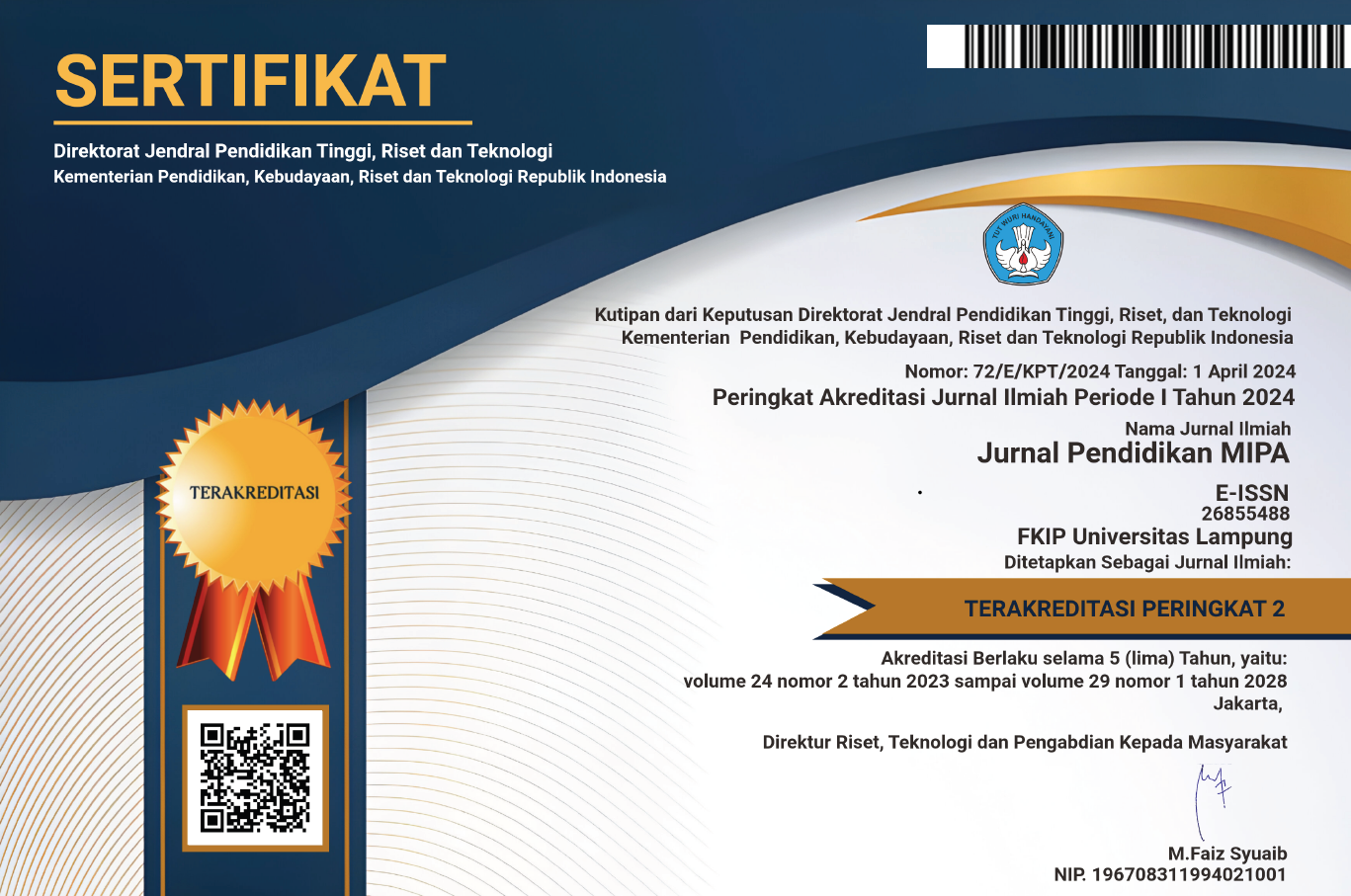Enhancing Motivation and Science Learning Outcomes of Elementary School Students using Animated Video: A Quasi-Experimental Study
 Country:
Country:
(1) Semarang State University, Indonesia
(2) Semarang State University, Indonesia
| Metrics→ |
| Indexing Site→ |
Copyright (c) 2025 Safitri Nur Inwanti, Deni Setiawan
IPAS learning, especially the material “My Indonesia is Rich in Culture” in elementary schools, still uses conventional media. The use of this media causes low student motivation, which has an impact on their interest, enthusiasm, and enthusiasm in participating in learning. Unattractive media often makes students bored quickly, so the delivery of material is not optimal. As a result, student learning outcomes are also unsatisfactory. One of the media that can increase students' interest and enthusiasm is animated video. This study aims to analyze and describe the effectiveness of learning media on motivation and learning outcomes in IPAS subjects. This type of research is a quantitative experiment with a quasi experimental design. The design used was nonequivalent control group design, with the population consisting of class IVA (27 students) as the experimental class and class IVB (27 students) as the control class, a total of 54 students. Data were collected through tests to measure learning outcomes and questionnaire sheets to measure learning motivation. Data analysis used Independent Sample t Test to test the difference and effectiveness of animated video media. The results showed that the application of animated video media was more effective than conventional media in learning IPAS material “My Indonesia is Rich in Culture.” The average value of student motivation in the experimental class reached 77.85, while in the control class it was only 74.15. For learning outcomes, the experimental class average was 85.96, compared to the control class which was 69.74. From the results of this study, it can be concluded that animated video media is more effective than conventional methods. Therefore, teachers are advised to innovate with more interesting learning media.
Keywords: animated video, motivation, learning outcomes.
Adri, H. T., Yudianto SA, Mawardini, A., & Sesrita, A. (2020). Using animated video based on scientific approach to improve students higher order thingking skill. Indonesian Journal of Social Research (IJSR), 2(1), 9–17. https://doi.org/10.30997/ijsr.v2i1.23
Caella, L. A., & Yulianto, S. (2024). The effectiveness of animation video media to increase interest and learning outcomes in science subjects. 10(9), 6621–6630. https://doi.org/10.29303/jppipa.v10i9.8445
Hirschfeld, C. G. , E., Rodríguez-Santos, M. Á., & López-Martín, C. (2025). Teaching economics in blended learning higher education: Use of whiteboard videos to engage the students. International Journal of Management Education, 23(2). https://doi.org/10.1016/j.ijme.2024.101124
Isti, L. A., Agustiningsih, A., & Wardoyo, A. A. (2022). Pengembangan media video animasi materi sifat-sifat cahaya untuk siswa kelas iv sekolah dasar. EduStream: Jurnal Pendidikan Dasar, 4(1), 21–28. https://doi.org/10.26740/eds.v4n1.p21-28
Keiler, L. S. (2018). Teachers’ roles and identities in student-centered classrooms. International Journal of STEM Education, 5(1), 34. https://doi.org/10.1186/s40594-018-0131-6
Kuhlmann, S. L., Plumley, R., Evans, Z., Bernacki, M. L., Greene, J. A., Hogan, K. A., Berro, M., Gates, K., & Panter, A. (2024). Students’ active cognitive engagement with instructional videos predicts STEM learning. Computers and Education, 216(February), 105050. https://doi.org/10.1016/j.compedu.2024.105050
Kurniawan, R., & A’la, F. (2021). Analisis validitas dan reliabilitas tes akurasi long pass (move ball long pass test) dalam permainan sepakbola pada mahasiswa kepelatihan FIK UNP. Jurnal Olahraga Kebugaran Dan Rehabilitasi (JOKER), 1(2), 83–97. https://doi.org/10.35706/joker.v1i2.5758
Li, J., Kizilcec, R., Bailenson, J., & Ju, W. (2016). Social robots and virtual agents as lecturers for video instruction. Computers in Human Behavior, 55, 1222–1230. https://doi.org/10.1016/j.chb.2015.04.005
M. Anggrayni, M. A., Susilawati, W. O., & Tamala, T. (2023). Pengembangan media pembelajaran video animasi berbasis tpack pada mata pelajaran IPAS Kelas IV SDN O1 Sitiung. Jurnal IKA PGSD (Ikatan Alumni PGSD) UNARS, 13(1), 51. https://doi.org/10.36841/pgsdunars.v13i1.3058
Muchlisin, R. (2022). Motivasi belajar - pengertian, fungsi, prinsip dan cara menumbuhkan. Jurnal Belajar. https://www.kajianpustaka.com/2022/01/motivasi-belajar-pengertian-fungsi.html
Pertiwi, B. I., ,.Isti, R., & Lukman, . Nulhakim. (2023). Development of animated video learning media using the powtoon application on the theme of caring for living things. Bioeduscience, 7(1), 106–117. https://doi.org/10.22236/jbes/7111429
Priayanto, D. (2020). Olah data sendiri analisis regresi linear dengan spss & analisis regresi data panel dengan eviews.
Priyatno, D. (2016). Panduan praktis olah data menggunakan SPSS. Andi Publisher.
Priyatno, D. (2024). Teknik dasar untuk analisis data menggunakan SPSS (Giovanny (ed.); cetakan I). Penerbit ANDI.
Putra, I. G. N. A., Kristiantari, M. G. R., & Wiarta, I. W. (2024). Media video animasi yang layak dan efektif diterapkan dalam pembelajaran ipa sekolah dasar. Jurnal Penelitian Dan Pengembangan Pendidikan, 8(1), 101–107. https://doi.org/10.23887/jppp.v8i1.74473
Qifsy, L. A., Hidayati, A., & Saputra, A. (2023). Pengembangan media video animasi pada mata pelajaran ipas kelas iv sd. Dharmas Education Journal (DE_Journal), 4(2), 762–769. https://doi.org/10.56667/dejournal.v4i2.1124
Sae, H., & Radia, E. H. (2023). Media video animasi dalam pembelajaran ipa untuk meningkatkan kemampuan berpikir kritis siswa SD. Indonesian Journal of Education and Social Sciences, 2(2), 65–73. https://doi.org/10.56916/ijess.v2i2.474
Safitri & Titin, E. (2021). Studi literatur: pengembangan media pembelajaran dengan video animasi powtoon. Jurnal Inovasi Penelitian Dan Pengabdian Masyarakat, 1(2), 74–80. https://doi.org/10.53621/jippmas.v1i2.12
Sari, W. N. (2024). Pengembangan video animasi berbasis canva sebagai media pembelajaran pai sd kelas 3. 11, 1–13. https://doi.org/10.31316/esjurnal.v11i2.431
Sugiyono. (2019). Buku metode penelitian sugiyono. Data Kualitatif, 981, 12.
Sugiyono, P. D. (2016). Metode penelitian pendidikan : pendekatan kuantitatif, kualitatif, dan R&D (Edisi ke-2). Alfabeta.
Susilawati, G., & Setiawan, D. (2019). Pengembangan media flash card aksara jawa untuk meningkatkan keterampilan membaca dan menulis. Joyful Learning Journal, 8(3), 149–153.
Traulsen, S. J., & Zander, L. (2024). Straighten your back, open your arms! Effects of instructor’s body postures in educational videos on students’ interest and motivation. Learning and Instruction, 93(June). https://doi.org/10.1016/j.learninstruc.2024.101959
Ujud, S., Nur, T. D., Yusuf, Y., Saibi, N., & Ramli, M. R. (2023). Penerapan model pembelajaran discovery learning untuk meningkatkan hasil belajar siswa sma negeri 10 kota ternate kelas x pada materi pencemaran lingkungan. Jurnal Bioedukasi, 6(2), 337–347. https://doi.org/10.33387/bioedu.v6i2.7305
Zhang, L., & Ma, Y. (2023). A study of the impact of project-based learning on student learning effects: a meta-analysis study. Frontiers in Psychology, 14. https://doi.org/10.3389/fpsyg.2023.1202728
Refbacks
- There are currently no refbacks.

This work is licensed under a Creative Commons Attribution-ShareAlike 4.0 International License.


